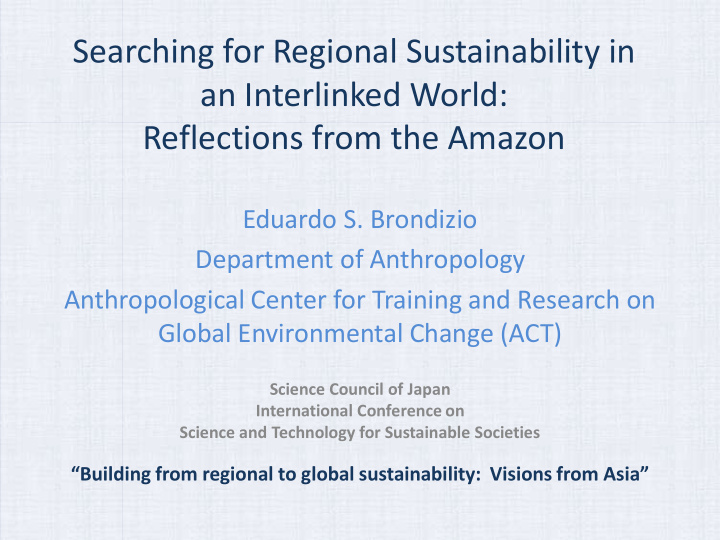



Searching for Regional Sustainability in an Interlinked World: Reflections from the Amazon Eduardo S. Brondizio Department of Anthropology Anthropological Center for Training and Research on Global Environmental Change (ACT) Science Council of Japan International Conference on Science and Technology for Sustainable Societies “Building from regional to global sustainability: Visions from Asia”
Presentation Outline 1. A case for parallels between the Amazon and Asian regions 1.1 Underlying social and economic contexts 1.2 Common analytical challenges 2. A region in transition: the last 40 years 2.1 Urbanization 2.2 LUCC & Deforestation 2.3 Boom of conservation units/Indigenous areas 3. Understanding the underlying mechanisms of change 3.1. Families, communities, and the rural-urban 3.2 LUCC and level-dependent factors 3.3 Commodity chains, tele-connections, recurrent under-development 4. Broader implications
1. A case for parallels between the Amazon and Asian regions: 1.1 Underlying conditions and trajectories UNDERLYING CONDITIONS . Policies of economic development . Structural adjustments . Demographic transitions . Social and cultural change TRAJECTORIES OF CHANGE . Intensity of urbanization . Deforestation and reforestation .Intensification and extensification . Complex institutional landscapes . Connectivity of economic systems The Brazilian Amazon: A Transforming Socio-ecological Mosaic
1. A case for parallels between the Amazon and Asian regions: 1.2 Common analytical challenges Disciplinary traditions and level specific research Structure vs. Agency Causality vs. teleconnections Historical conditions and intra-regional variability Complex systems and policy
Research sites Longitudinal Cross-sectional Nested sampling INTEGRATIVE METHODOLOGIES Ethnography Household and community survey Historical/Archival Remote sensing/Geospatial analysis Social network Ecological assessments
2. Regional trajectories: the last 40 years Urbanization, LUCC and Deforestation, and Reserves
Brazilian Amazon: Formation of urban centers and population 1980 1970 2000 1990 Costa, S. M. and E. S. Brondizio. 2009 Inter-Urban Dependency among Amazonian Cities: Urban Growth, Infrastructure Deficiencies, and Socio-Demographic Networks. REDES (Brazil) 14(3): 211 – 234
Deforestation and land cover change Geopolotical strategy Road network Agropastoral expansion Regional trends, intra-regional variability
Conservation units, indigenous reserves, community management areas -Social movements- Environmentalist alliance -International-national pressure against deforestation Source: IPAM -Co-existence with incentives for agro- pastoral expansion A mosaic of institutional arrangements: 35% of the region designated as indigenous reserve, protected area, and different types of management reserve
What have we learned about the underlying processes and mechanisms of change? .Formation of rural settlements and urban areas .Commodity chains and resource export .Scale-dependent LUCC trajectories .Interdependent institutional arrangements
The Formation of Urban Systems and Inter-regional urban networks Model Three levels of hierarchy 1 st Process of Urban Growth from a Rural Structure Market Social network Access* Mobility Services* Associations Rural (Rural Properties) ------ Villages -------------- Small Cities 2 nd Configuration Process of Interurban and Subregional Network Market Access* Mobility* Services Social Network Small/Medium Cities ------------------------------------ Small/Medium Cities 3 rd Development of Amazon Urban Network Market* Services* Telecommunication network Transport system* Political centers* Industrial centers* Mobility* Infrastructure* Large Cities -------- Large Cities Guedes, G., S. M. Costa, and E. S. Brondizio. 2009. Revisiting the Hierarchy of Urban Areas in the Brazilian Amazon: a multilevel model using multivariate fuzzy cluster methodology. Population and Environment 30(4):159-170
The emergence of multi-sited households and rural-urban social networks Marajo Island, Amazon estuary, State of Para Brondizio, E. S. forthcoming. Forest Resources, City Services: Globalization, Household Networks, and Urbanization in the Amazon estuary. In K. Morrison, S. Hetch, and C. Padoch (eds). The Social Life of Forests. Chicago, IL: The University of Chicago Press.
Rural properties with Associated Urban Households in 2005 � Unpublished A. Cak, dissertation research 2011
Recommend
More recommend